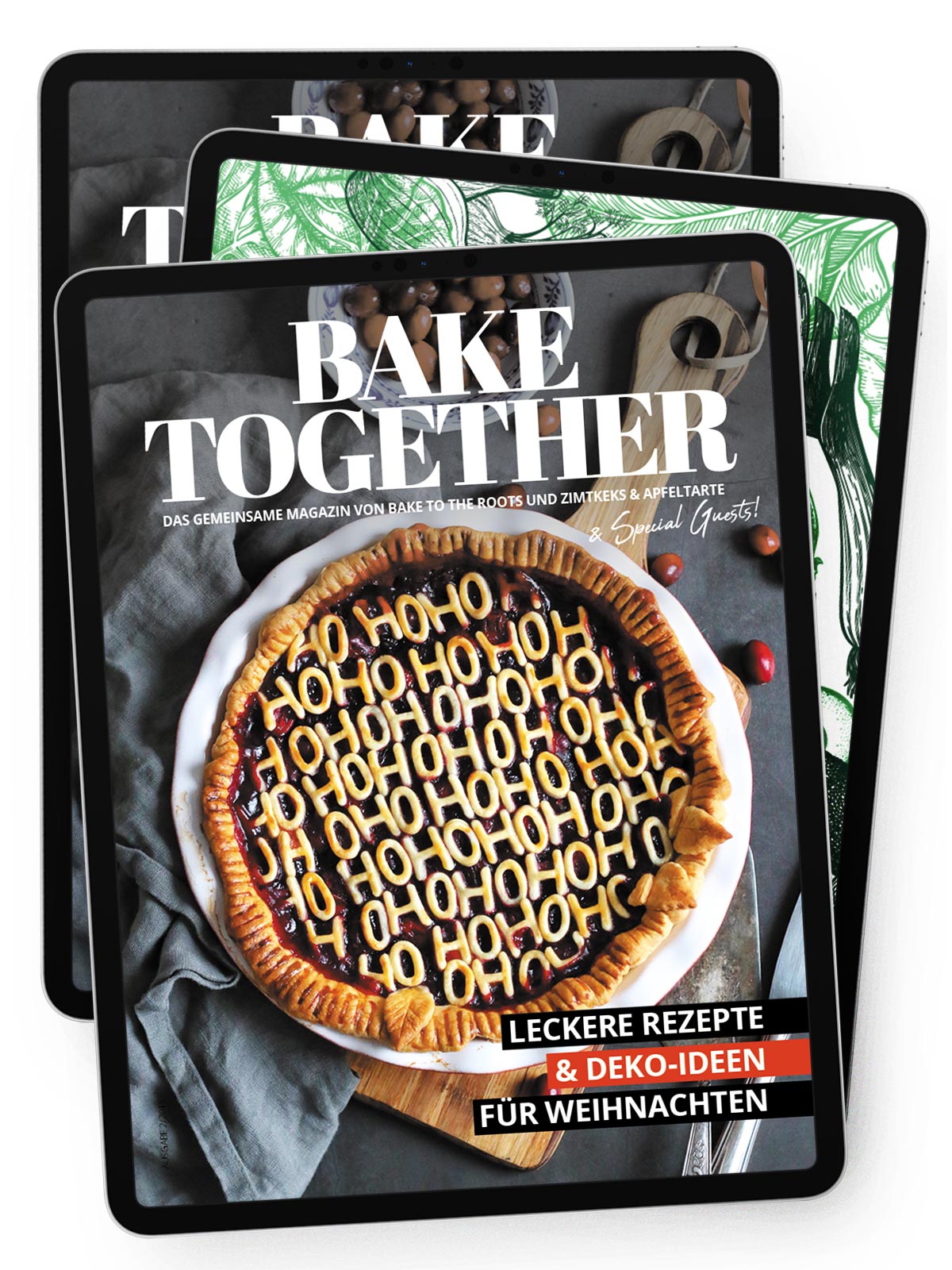Whenever I am in Hamburg because of my job or just for fun, it is impossible for me to pass by a bakery without getting a Franzbrötchen. I’m so much in love with them since my first bite ;P
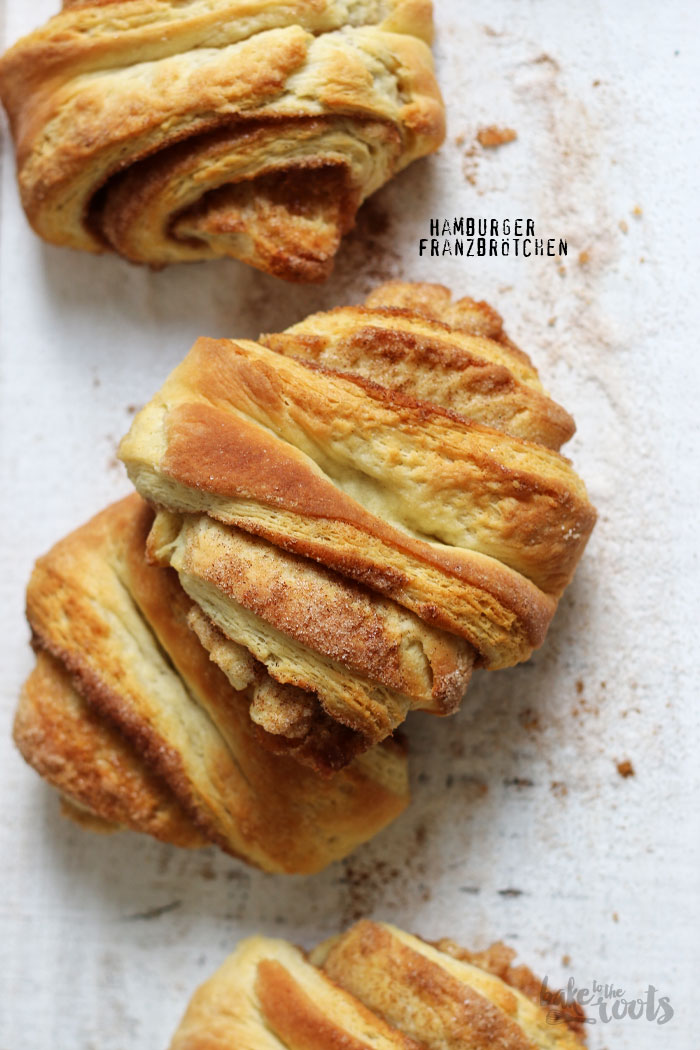
For people from the North of Germany it’s probably something they know since they are small kids – I guess there is nobody that does not love pastry bakes with cinnamon ;) I myself discovered those little fellas pretty late. In Southern Germany they were not sold in many places when I was young. At least the bakery I was going to all the time, did not have them.
When I was studying, I lived in Hamburg for some time and back then it happened :) I fell in love with Franzbrötchen. They are basically all over the place and if you are new in town, you have to try the things the “native” do and eat :P There was nothing better than a fresh baked Franzbrötchen on a sunday morning coming back from a party – a light snack before going to sleep :P
Maybe I should also tell you something about the Franzbrötchen as well. They are made with a regular pastry dough and filled with cinnamon – similar to cinnamon rolls. The difference is the shape – you roll up the dough, cut off stripes (like you would with cinnamon rolls) and then you press the center down with a wooden spoon to get the special shape. Easy as that. I made some Franzbrötchen with Kale not too long ago – there you can see on the pictures what I mean :)
INGREDIENTS / ZUTATEN
For the dough:
3/4 cup (180ml) milk
1 tsp. sugar
1 oz. (30g) fresh yeast
4 1/4 cups (550g) all-purpose flour
2 tsp. salt
1/3 cup (75g) butter
1/4 cup (50g) sugar
2 eggs
1 cup (230g) cold butter
For the filling:
2 tbsp. ground cinnamon
1/c cup (100g) sugar
water
Für den Teig:
180ml Milch
1 TL Zucker
30g frische Hefe
550g Mehl (Type 550)
2 TL Salz
75g Butter
50g Zucker
2 Eier
230g kalte Butter
Für die Füllung:
2 EL Zimt
100g Zucker
Wasser
DIRECTIONS / ZUBEREITUNG
2. In a small bowl mix the lukewarm milk with the sugar and the yeast until completely dissolved. Cover and let sit for 5 minutes. Sift the flour into a large bowl and add the salt, the butter in small pieces, sugar, eggs and the yeast-milk mixture. Knead until you get a nice smooth dough (with a food processor), then knead some minutes with your hands on a floured surface and form a ball – place in the bowl again and cover with plastic wrap. Place in the oven and let rise for about 45-60 minutes – the size should almost double.
3. Wile the dough is rising in the oven, take the cold butter and wrap loosely in plastic wrap. Take a rolling pin and hit it several times so it softens, then roll out to a 0.4 inch (1cm) thick square. It works best if you loosen the plastic wrap in between so it does not tear apart. When you’re done, place the butter square (wrapped in plastic wrap again) in the fridge to cool. The butter has to be cool, so you get layers at the end.
4. Roll out the dough on a floured surface to a square (it should be bigger than your butter square). Unwrap your butter, place it on the dough and fold the dough like an envelope over the butter. Make sure the butter is sealed in completely, then turn around and roll out to a long rectangle. Fold the ends towards the middle, one over the other to get three layers – flatten a bit. Wrap the dough in plastic wrap and place in the fridge for 20 minutes.
5. Take the dough out of the fridge go for another rolling/folding round – this time fold both sides to the middle and then one over the other to get 4 layers – flatten a bit and wrap in plastic wrap. Place once more in the fridge for 20 minutes. Mix cinnamon and sugar in a small bowl and set aside.
6. Preheat the oven to 390˚F (200°C). Line two baking sheets with baking parchment. Take the dough out of the fridge and roll out to a large rectangle. Brush the dough with some water and sprinkle with the cinnamon-sugar mixture – press a bit onto the dough. Roll up to a log from the long side and cut into 2 inch (5cm) thick slices. Flatten them a bit and use the back of a wooden spoon to make a “notch” into the roll – dough and sugar filling should ooze out a bit on the left and right – that gives the “franzbröchen” their typical shape. Place on the baking sheets with space in between (they get bigger) and bake for 15-20 minutes. They should get a nice color but not too dark. Take out of the oven and let cool down on a wire rack completely.
2. In einer kleinen Schüssel die lauwarme Milch mit Zucker und zerbröckelter Hefe verrühren und abgedeckt etwa 5 Minuten gehen lassen. Das Mehl in eine große Schüssel sieben, Salz, die Butter in kleinen Stücken, Zucker, Eier und Hefemilch zugeben und alles mit den Knethaken der Küchenmaschine oder dem Handrührer zu einem glatten Teig verkneten. Auf einer bemehlten Arbeitsfläche noch einmal kurz mit den Händen durchkneten und dann zu einer Kugel formen. Zurück in die Schüssel legen und mit Plastikfolie oder einem Küchentuch abdecken und im ausgeschalteten, aber noch etwas warmen Ofen für etwa 45-60 Minuten gehen lassen – das Volumen sollte sich in fast verdoppelt haben.
3. Während der Teig im Ofen geht, die kalte Butter locker in ein großes Stück Klarsichtfolie einschlagen und mit einem Nudelholz erst etwas breit schlagen und dann zu einem etwa 1cm (0.4 inch) dicken, quadratischen Block ausrollen. Die Klarsichtfolie dabei immer wieder mal abziehen und erneut darüberlegen, damit sie nicht einreißt. Den Butterblock wieder in Folie einwickeln und in den Kühlschrank legen, damit er gut durchkühlt.
4. Den Teig auf einer bemehlten Fläche zu einem Quadrat ausrollen (es sollte so groß sein, dass man die Butterplatte damit einschlagen kann) – die Butter aus der Folie nehmen, auf den Teig legen und dann wie bei einem Briefumschlag die Ränder des Teiges über der Butter einschlagen. Das ganze Umdrehen, damit die Teignähte unten sind und dann auf der bemehlten Fläche vorsichtig zu einem länglichen Rechteck ausrollen. Die langen Seiten zur Mitte hin über einanderschlagen und festdrücken – es entstehen drei Schichten Teig. In Klarsichtfolie wickeln und für 20 Minuten in den Kühlschrank legen.
5. Den Teig aus dem Kühlschrank nehmen und das Prozedere wiederholen – also den Teig noch einmal länglich ausrollen (geht am besten, wenn man die offene Teigseite zu sich zeigen lässt beim Ausrollen) und dann wieder übereinander schlagen – diesmal allerdings so, dass man beide Seiten zur Mitte hin einschlägt und dann eine Seite noch einmal über die andere – jetzt entstehen 4 Teigschichten. Etwas festdrücken und in Klarsichtfolie einschlagen. Noch einmal in den Kühlschrank für 20 Minuten. In einer kleinen Schüssel Zucker mit Zimt vermischen und zur Seite stellen.
6. Den Ofen auf 200°C (390°F) vorheizen. Zwei Bleche mit Backpapier auslegen. Den Teig aus dem Kühlschrank nehmen und auf einer bemehlten Fläche zu einem großen Rechteck ausrollen. Den Teig mit etwas Wasser einstreichen und dann die Zuckermischung darauf verteilen und festdrücken. Den Teig von der langen Seite her aufrollen. Die Rolle in ca. 5cm (2 inch) dicke Scheiben schneiden, diese dann etwas flachdrücken und mit einem Holzstab (oder Ende eines Kochlöffels) in die Mitte eine Kerbe drücken – wenn sich dadurch das Innere der Rolle rechts und links etwas nach Außen drückt, dann ist es genau richtig. Mit etwas Abstand auf die Bleche legen – die Franzbrötchen gehen einiges auf. Für 15-20 Minuten backen. Die Franzbrötchen sollten schön Farbe bekommen haben, aber nicht zu dunkel werden. Auf einem Kuchengitter komplett abkühlen lassen.
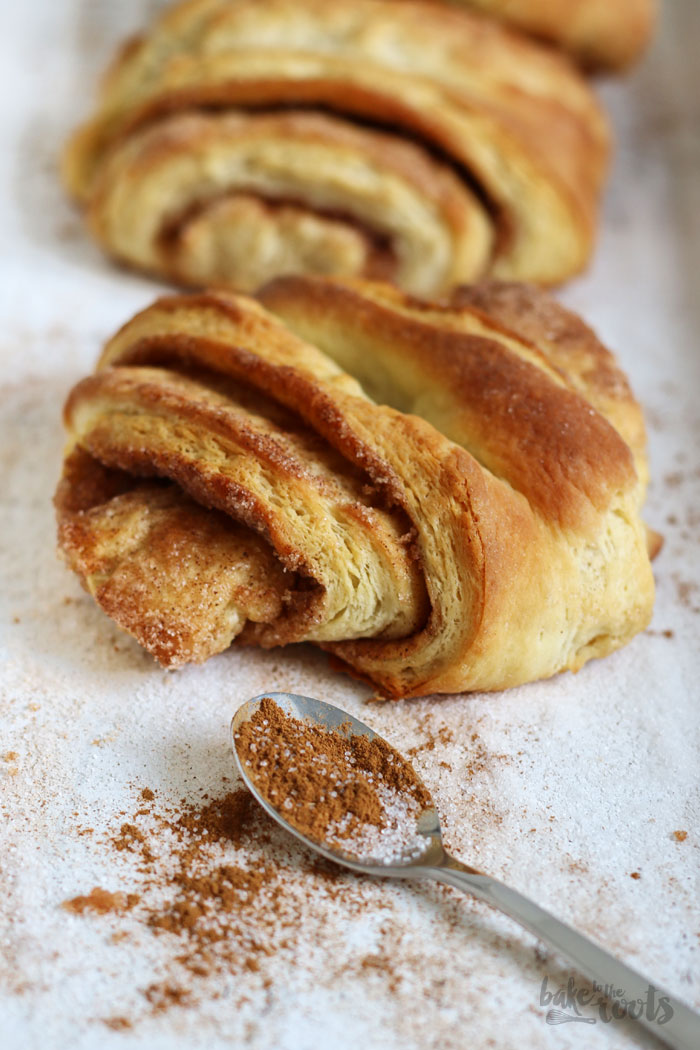
Craving more? Keep in touch on Facebook, Twitter, Instagram and Pinterest for new post updates and more. You can also contact me with any questions or inquiries!
Here is a version of the recipe you can print easily.
Print
Hamburger Franzbrötchen aka. Cinnamon Pastry
- Prep Time: 60
- Cook Time: 20
- Total Time: 180
- Yield: 12 1x
Ingredients
For the dough
- 3/4 cup (180ml) milk
- 1 tsp. sugar
- 1 oz. (30g) fresh yeast
- 4 1/4 cups (550g) all-purpose flour
- 2 tsp. salt
- 1/3 cup (75g) butter
- 1/4 cup (50g) sugar
- 2 eggs
- 1 cup (230g) cold butter
For the filling
- 2 tbsp. ground cinnamon
- 1/c cup (100g) sugar
- water
Instructions
- Preheat the oven to 120˚F (50°C) an then turn it off again – this is for the dough to rise.
- In a small bowl mix the lukewarm milk with the sugar and the yeast until completely dissolved. Cover and let sit for 5 minutes. Sift the flour into a large bowl and add the salt, the butter in small pieces, sugar, eggs and the yeast-milk mixture. Knead until you get a nice smooth dough (with a food processor), then knead some minutes with your hands on a floured surface and form a ball – place in the bowl again and cover with plastic wrap. Place in the oven and let rise for about 45-60 minutes – the size should almost double.
- Wile the dough is rising in the oven, take the cold butter and wrap loosely in plastic wrap. Take a rolling pin and hit it several times so it softens, then roll out to a 0.4 inch (1cm) thick square. It works best if you loosen the plastic wrap in between so it does not tear apart. When you’re done, place the butter square (wrapped in plastic wrap again) in the fridge to cool. The butter has to be cool, so you get layers at the end.
- Roll out the dough on a floured surface to a square (it should be bigger than your butter square). Unwrap your butter, place it on the dough and fold the dough like an envelope over the butter. Make sure the butter is sealed in completely, then turn around and roll out to a long rectangle. Fold the ends towards the middle, one over the other to get three layers – flatten a bit. Wrap the dough in plastic wrap and place in the fridge for 20 minutes.
- Take the dough out of the fridge go for another rolling/folding round – this time fold both sides to the middle and then one over the other to get 4 layers – flatten a bit and wrap in plastic wrap. Place once more in the fridge for 20 minutes. Mix cinnamon and sugar in a small bowl and set aside.
- Preheat the oven to 390˚F (200°C). Line two baking sheets with baking parchment. Take the dough out of the fridge and roll out to a large rectangle. Brush the dough with some water and sprinkle with the cinnamon-sugar mixture – press a bit onto the dough. Roll up to a log from the long side and cut into 2 inch (5cm) thick slices. Flatten them a bit and use the back of a wooden spoon to make a “notch” into the roll – dough and sugar filling should ooze out a bit on the left and right – that gives the “franzbröchen” their typical shape. Place on the baking sheets with space in between (they get bigger) and bake for 15-20 minutes. They should get a nice color but not too dark. Take out of the oven and let cool down on a wire rack completely.
Notes
- Enjoy baking!

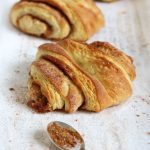
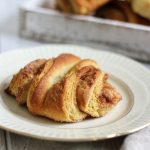
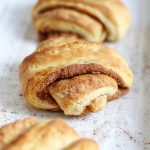

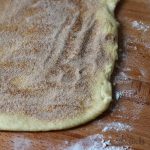


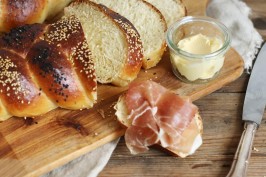
 I love my job, but in between I love to bake and try new things in the kitchen. A lot of my friends and colleagues encourage me to bake - for a very simple reason: they get the leftovers - and it seems they like it most of the time ;)
I love my job, but in between I love to bake and try new things in the kitchen. A lot of my friends and colleagues encourage me to bake - for a very simple reason: they get the leftovers - and it seems they like it most of the time ;) 